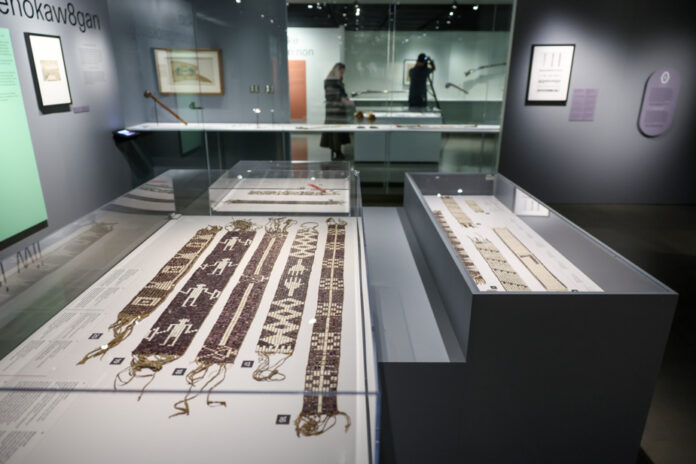The McCord Stewart Museum brings together for the first time in North America around forty wampum necklaces, these belts made from marine shell beads which were used to weave alliances between indigenous nations, but also with the French and the English, from the 17th to the 19th century.
“When we talk about 40 necklaces, it may not seem like much to us, but when we know that there are 200 to 250 left in the world, it’s a good percentage,” says Jonathan Lainey, curator of Indigenous cultures at the McCord Stewart Museum. .
But what exactly were these “porcelain necklaces,” reminiscent of scarves first made by the Iroquoian nations, for? “They embodied the word given during agreements and alliances,” explains Anne Eschapasse, president and CEO of the McCord Stewart Museum. They have been passed down from generation to generation to preserve and remember past commitments. »
Co-produced with the Musée du quai Branly-Jacques-Chirac in Paris, which has a collection of 18 necklaces, the Wampum: pearls of diplomacy exhibition also highlights the collection of the McCord Museum, which has 13 necklaces. The other objects in the exhibition – wampums, but also ornaments, guns, maps, engravings, etc. – come from, among others, the Canadian Museum of History, the Museum of Civilization and Parks Canada.
It was the Musée du quai Branly-Jacques-Chirac in Paris which took the initiative to put together this exhibition in 2019 based on its collection of 250 objects dating from the 17th and 18th centuries, which come from North America, during the period of the First French Colonial Empire. From this collection, French co-curator Paz Nuñez-Regueiro focused on wampums, so she contacted Jonathan Lainey, a historian born in Wendake, member of the Huron-Wendat nation, specialist on the subject.
Sometimes, wampums evoke war, sometimes peace, or even alliances. “On war wampums, we find red axes, to signify a state of war,” explains Jonathan Lainey. Conversely, the wampums which evoke peace were made on a white background, there is often a pipe there. The wampums which symbolize alliances represent human silhouettes connected by a chain, a path or outstretched hands. »
Two wampum necklaces found at Chartres Cathedral are on display at McCord. A “gift from the Abenakis to the Virgin Mary”, made in 1699, which contains 11,000 pearls, as well as a Huron-Wendat necklace dated 1678, where we can read the Latin inscription “wishes from the Hurons to the Virgin “. “Wampums with Latin writings, between 1654 and 1716, there were 10 or 12 that were made, most of them were burned in the Wendake chapel,” Jonathan Lainey tells us. There are three left in the world, two in Chartres, one at the Musée du quai Branly, this is the first time that all three have been found in their original territory. Chartres responded to them with a reliquary, which is also here, I find it moving. »
Wampums were therefore used to confirm and seal alliances. So we are talking about verbal agreements, but is there a written record of these agreements? “To find common ground in their exchanges with their indigenous interlocutors, the French numbered the wampums. So, when we look at the colonial correspondence, there are minutes associated with wampums [minutes]. Since the 1980s, there have been around fifty instances where wampums have been mentioned in Canadian courts, as proof of their past rights. »
One of the wampums on display is British made. Proof, according to the commissioners, that Europeans also used it in their alliances with indigenous peoples. “If we say that these wampums are witnesses of international alliances, for example the wampum where we see the ax of George III, which is a military alliance, it is clear that this alliance allowed the establishment of the British , tells us the co-curator of the exhibition Jonathan Lainey. By saying this, I am saying that these wampum necklaces are witnesses of founding alliances in the country. This is major! »
You can also see a wampum made in Kanesatake by three indigenous nations, the Algonquin, Nepissing and Mohawk, who gave the necklace to Pope Gregory XVI in 1831. It has been in the Vatican ever since. This is the first time he has found himself here, in his home territory. It’s here until December 5th. “It’s probably the last or one of the last wampums,” says Jonathan Lainey, “because after the War of 1812, wampums were no longer made in diplomatic international exchanges. We refer to them, but we no longer make them, writing prevails over orality. »















